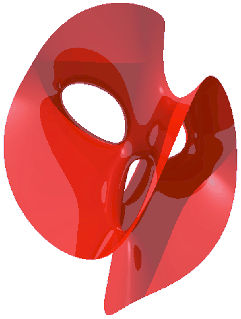|
|
|

A Cubic Algebraic Surface given by the equation
| (1) |
| (2) |
|
|
|
|
|
(3) |
If one of the variables describing Clebsch's diagonal surface is dropped, leaving the equations
| (4) |
| (5) |
| (6) |
See also Cubic Surface, Eckardt Point
References
Fischer, G. (Ed.). Mathematical Models from the Collections of Universities and Museums.
Braunschweig, Germany: Vieweg, pp. 9-11, 1986.
Fischer, G. (Ed.). Plates 10-12 in
Mathematische Modelle/Mathematical Models, Bildband/Photograph Volume. Braunschweig, Germany: Vieweg, pp. 13-15, 1986.
Hunt, B. The Geometry of Some Special Arithmetic Quotients. New York: Springer-Verlag, pp. 122-128, 1996.
Nordstrand, T. ``Clebsch Diagonal Surface.''
http://www.uib.no/people/nfytn/clebtxt.htm.